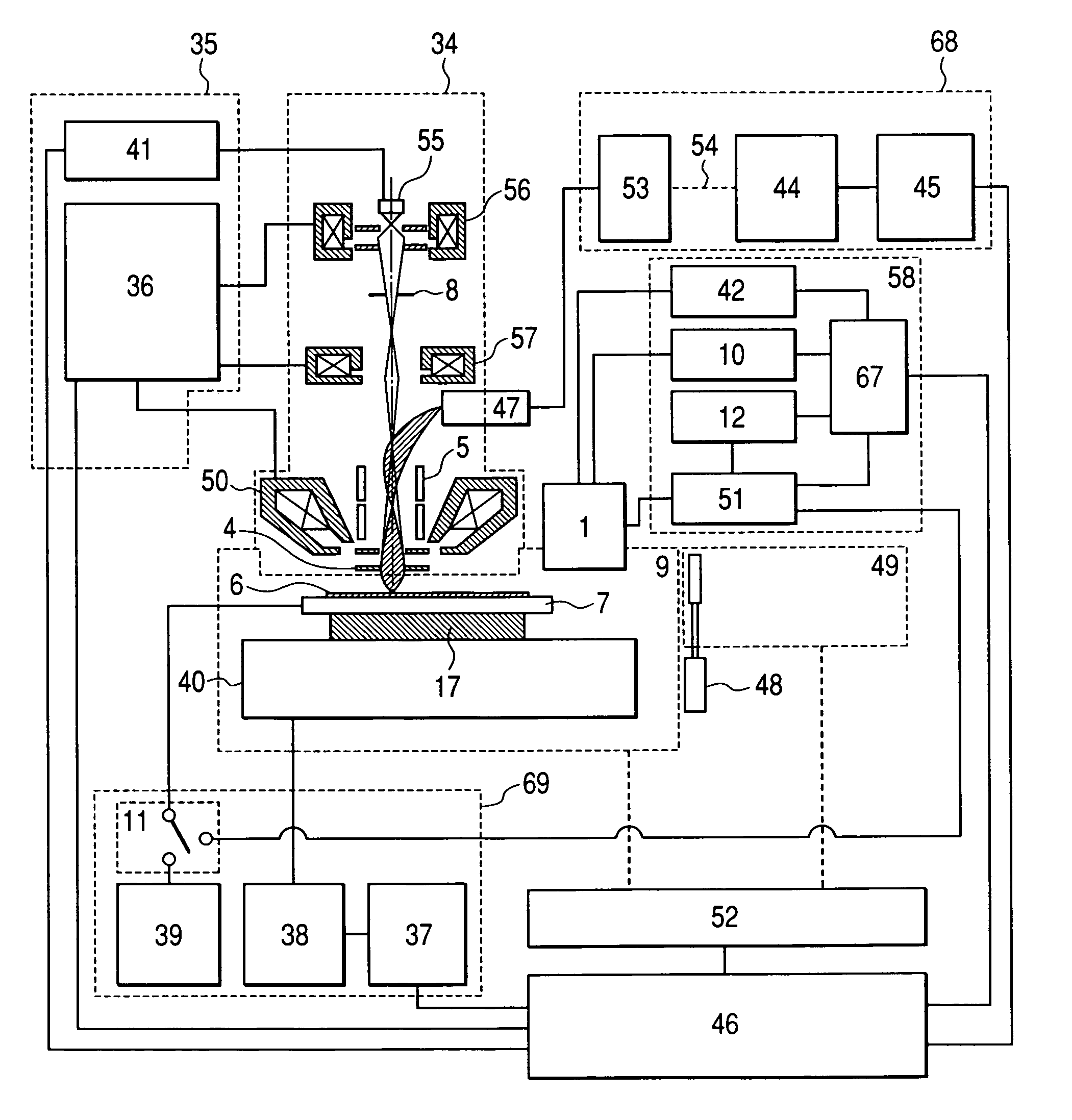Charge control apparatus and measurement apparatus equipped with the charge control apparatus
a control apparatus and charge control technology, applied in the direction of instruments, nuclear engineering, and fault location by increasing destruction at fault, can solve the problems of inconvenient installation of observation means suitable for semiconductor inspection instruments, measurement accuracy may deteriorate, and measurement accuracy may be too large to be measured separately as a second electron source, etc., to achieve the effect of improving repeatability, high speed, and performing charge processing efficiently
- Summary
- Abstract
- Description
- Claims
- Application Information
AI Technical Summary
Benefits of technology
Problems solved by technology
Method used
Image
Examples
first embodiment
[0045]In this embodiment, an example of one configuration of an SEM type semiconductor inspection instrument to which charge processing technology is applied will be explained. The SEM type semiconductor inspection instrument explained in this embodiment has a configuration where a charged particle beam illumination system for charge control and an SEM column are arraigned in parallel to a specimen, having a feature that a charge control beam is irradiated perpendicularly on a semiconductor wafer that is an inspection target. Moreover, in this embodiment, especially an embodiment that uses a CNT cathode as a charged particle beam source for charge control will be explained.
[0046]For a charged particle beam source for charge control, an electron source capable of illuminating a large area with a large current and realizing stable emission is preferable. The CNT cathode can irradiate a large area at one time and operate without heating at a degree of vacuum of about 1×10−4 [Pa], and c...
second embodiment
[0081]In the electron beam application device shown in the first embodiment, charge on the specimen surface is controlled using the charge control column provided adjacent to the SEM column, uses both scanning of electrons and movement of the stage together, and renders charge uniform. In the second embodiment, the electron beam application instrument equipped with an charge control function in the specimen reparatory chamber was explained. Moreover, the charge control apparatus of this embodiment is different from the charge control apparatus explained in the first embodiment in that its operating principle is not charge control by the charge control electrode, charge on the specimen surface is controlled with incident energy of the primary electron beam that irradiates a specimen, and the charge control apparatus is relatively moved to the specimen to render charge uniform.
[0082]FIG. 9 shows an example of a semiconductor pattern inspection instrument with which the above-mentioned...
third embodiment
[0091]In the first Embodiment, an example of the SEM type semiconductor inspection instrument where the electron beam emitted from the electron gun for charge control is irradiated in parallel to the specimen was explained. In this embodiment, another example of configuration of the SEM type semiconductor inspection instrument will be described. A feature of the SEM type semiconductor inspection instrument of this embodiment is a capability to realize charge control processing by incorporating a small electron gun into the conventional SEM column. At this time, electron illumination is done by the electron gun, and charge processing for controlling the charge is performed by using an charge control electrode provided in the SEM column.
[0092]FIG. 13 shows a general view of the semiconductor inspection instrument of this embodiment. The semiconductor inspection instrument of this embodiment is roughly divided into: an SEM column 34, a charge control column 1, the specimen chamber 9, t...
PUM
 Login to View More
Login to View More Abstract
Description
Claims
Application Information
 Login to View More
Login to View More - R&D
- Intellectual Property
- Life Sciences
- Materials
- Tech Scout
- Unparalleled Data Quality
- Higher Quality Content
- 60% Fewer Hallucinations
Browse by: Latest US Patents, China's latest patents, Technical Efficacy Thesaurus, Application Domain, Technology Topic, Popular Technical Reports.
© 2025 PatSnap. All rights reserved.Legal|Privacy policy|Modern Slavery Act Transparency Statement|Sitemap|About US| Contact US: help@patsnap.com



